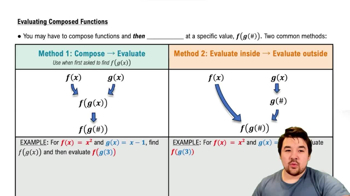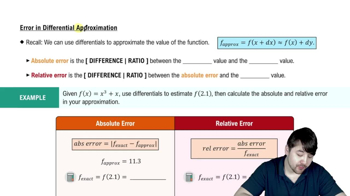Table of contents
- 0. Functions7h 52m
- Introduction to Functions16m
- Piecewise Functions10m
- Properties of Functions9m
- Common Functions1h 8m
- Transformations5m
- Combining Functions27m
- Exponent rules32m
- Exponential Functions28m
- Logarithmic Functions24m
- Properties of Logarithms34m
- Exponential & Logarithmic Equations35m
- Introduction to Trigonometric Functions38m
- Graphs of Trigonometric Functions44m
- Trigonometric Identities47m
- Inverse Trigonometric Functions48m
- 1. Limits and Continuity2h 2m
- 2. Intro to Derivatives1h 33m
- 3. Techniques of Differentiation3h 18m
- 4. Applications of Derivatives2h 38m
- 5. Graphical Applications of Derivatives6h 2m
- 6. Derivatives of Inverse, Exponential, & Logarithmic Functions2h 37m
- 7. Antiderivatives & Indefinite Integrals1h 26m
- 8. Definite Integrals4h 44m
- 9. Graphical Applications of Integrals2h 27m
- 10. Physics Applications of Integrals 2h 22m
4. Applications of Derivatives
Differentials
Problem 4.8.15
Textbook Question
{Use of Tech} Finding roots with Newton’s method For the given function f and initial approximation x₀, use Newton’s method to approximate a root of f. Stop calculating approximations when two successive approximations agree to five digits to the right of the decimal point after rounding. Show your work by making a table similar to that in Example 1.
f(x) = sin x + x - 1; x₀ = 0.5
 Verified step by step guidance
Verified step by step guidance1
Step 1: Understand Newton's Method. Newton's method is an iterative process used to approximate the roots of a real-valued function. The formula for Newton's method is: x_{n+1} = x_n - \frac{f(x_n)}{f'(x_n)}.
Step 2: Calculate the derivative of the function. For the given function f(x) = sin(x) + x - 1, the derivative f'(x) is cos(x) + 1.
Step 3: Set up the iterative formula. Using the initial approximation x₀ = 0.5, apply the Newton's method formula: x_{n+1} = x_n - \frac{sin(x_n) + x_n - 1}{cos(x_n) + 1}.
Step 4: Perform the iterations. Start with x₀ = 0.5 and calculate x₁ using the formula. Continue calculating successive approximations x₂, x₃, etc., until two successive approximations agree to five decimal places.
Step 5: Create a table to track the iterations. The table should include columns for n (iteration number), x_n (current approximation), f(x_n), f'(x_n), and the difference |x_{n+1} - x_n|. Stop when the difference is less than 0.00001.
 Verified video answer for a similar problem:
Verified video answer for a similar problem:This video solution was recommended by our tutors as helpful for the problem above
Video duration:
8mPlay a video:
Was this helpful?
Key Concepts
Here are the essential concepts you must grasp in order to answer the question correctly.
Newton's Method
Newton's Method is an iterative numerical technique used to find approximate roots of a real-valued function. It starts with an initial guess and refines it using the formula x₁ = x₀ - f(x₀)/f'(x₀), where f' is the derivative of f. This process continues until the difference between successive approximations is sufficiently small, indicating convergence to a root.
Recommended video:

Evaluating Composed Functions
Convergence Criteria
In the context of Newton's Method, convergence criteria define when to stop the iterative process. For this problem, the iterations should continue until two successive approximations agree to five decimal places. This ensures that the approximation is accurate enough for practical purposes and helps avoid unnecessary calculations.
Recommended video:

Derivatives
Function and Derivative Evaluation
To apply Newton's Method, it is essential to evaluate both the function f(x) and its derivative f'(x) at each iteration. For the given function f(x) = sin x + x - 1, the derivative f'(x) = cos x + 1 must also be computed. Accurate evaluation of these functions is crucial for obtaining correct approximations of the root.
Recommended video:

Evaluating Composed Functions







